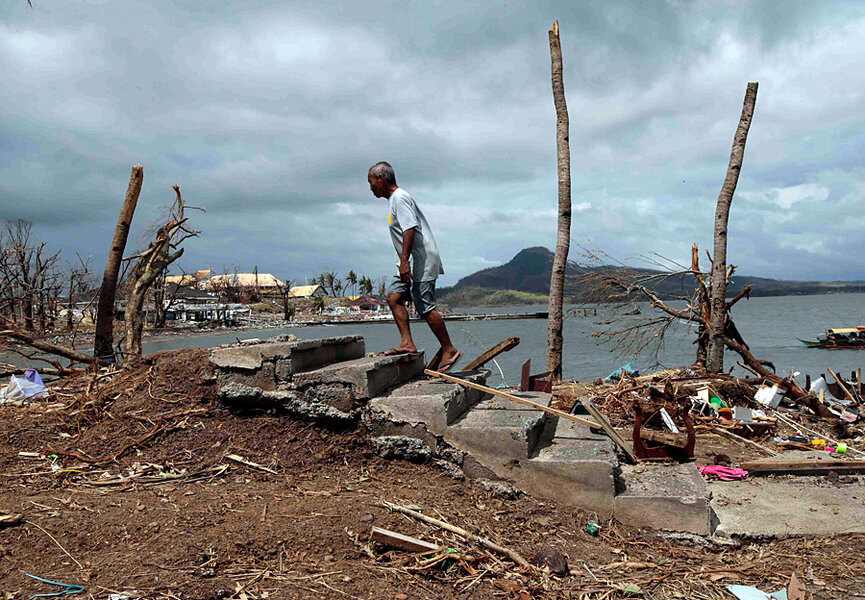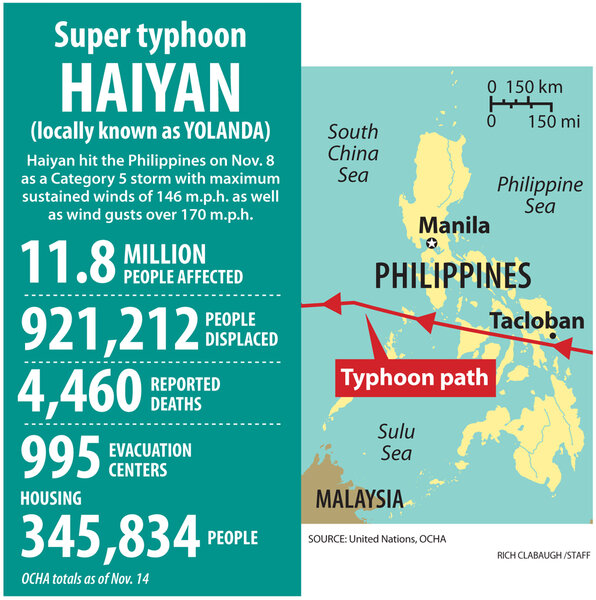Typhoon Haiyan: Is an era of super storms upon us?
Loading...
Typhoon Haiyan, vying for the title of strongest tropical cyclone on record, may or may not ultimately capture the title. But the damage and casualties it inflicted on the Philippines and other countries along its track underscore the future that tropical-cyclone-prone regions are likely to face, as the climate continues to warm during this century and as people continue to gravitate to coastal areas, research indicates.
Even without climate change, the annual economic toll from tropical cyclone disasters is expected to double worldwide by the end of the century, as more people live along coastlines. The toll grows even higher with the projected impact of global warming on tropical cyclone activity.
Some see typhoon Haiyan as the latest indicator of that future, as the climate continues to warm.
Up to this point, climate scientists say it's unclear how much global warming has influenced tropical cyclone activity over the past few decades. They caution that the historical record of tropical cyclones globally, especially in regions outside of the tropical North Atlantic, is too poor to allow them to track trends in ways that would reveal any fingerprint of global warming on storm numbers and intensities.
Even in the North Atlantic, where the number and intensity of the strongest storms have increased during the past 30 to 40 years, researchers are still trying to sort out the relative contribution of various proposed causes for the trend, according to the latest report on the state of climate science from the Intergovernmental Panel on Climate Change, released in September.
These range from global warming's direct effect on air and sea-surface temperatures to natural climate swings such as the Atlantic Multidecadal Oscillation, which produces alternating periods of warmer- and cooler-than-normal water temperatures near the ocean surface in 60-year cycles. The Atlantic currently is in a warm phase of this cycle, on average providing extra energy for tropical cyclones, which feed off of warm water.
Global warming is changing the background conditions under which storms form and evolve, notes Kevin Trenberth, a climate researcher at the National Center for Atmospheric Research in Boulder, Colo.
Warmer air temperatures, for instance, allow the atmosphere to hold more moisture in a process that also can change atmospheric circulation patterns.
“There are enough fundamental changes going on in the atmosphere due to global warming that they have to be affecting tropical cyclones,” says Jeff Masters, director of meteorology at the Weather Underground. "But tropical cyclones vary so much naturally that we really can't see the influence yet.”
As for the future, modeling studies indicate that by century's end a warmer world likely would see fewer tropical cyclones overall but a higher proportion of the most intense storms. But that picture may be changing.
Both the number and intensity of tropical cyclones are likely to increase by the end of the century, according to a study conducted by Kerry Emanuel, a scientist at the Massachusetts Institute of Technology in Cambridge, Mass., who specializes in tropical cyclones and the conditions that spawn them. The latest modeling study, published in July, found that, compared with tropical cyclone activity between 1950 and 2005, activity between 2006 and 2100 could rise between 10 and 40 percent globally, with the amount of energy released increasing by 45 percent from one period to the next.
The largest increases in number and intensity are projected for the northwestern Pacific, the region that typhoon Haiyan struck.
Indeed, this area experiences more topical cyclones than any ocean basin on Earth, according to records kept at the National Oceanic and Atmospheric Administration's Atlantic Oceanographic and Meteorological Laboratory (NOAA) in Miami. The northwest Pacific averages 26 tropical cyclones a year, followed by the northeast and central Pacific. The Atlantic, by contrast, averages about 12 tropical cyclones a year.
The reason: The basin hosts the largest, deepest pool of warm water on Earth – stretching from the island chains of the western Pacific well into the central part of the ocean. The pool owes its presence to a convergence of two undersea currents carrying warm water, as well as to the easterly trade winds, which pile up the water, bathtub-like, against the island chains.
Even in winter, the water is warm enough to spawn tropical cyclones, researchers say. When storms do form, their paths carry them over warm water far longer than is the case in any other ocean basin. And the depth of the warm water means that, as the storms travel, they churn up more warm water – a kind of inflight refueling. This gives them the time and energy to build into super typhoons.
Those background conditions have been intensifying over the past several decades, according to two recent studies. One, released in March, showed how the average strength of the trade winds has been increasing since the 1950s. The other study documented a 10 percent increase in the depth of the western Pacific warm pool and its potential for delivering heat to tropical cyclones. That team, led by Iam-Fei Pun at the Woods Hole Oceanographic Institution in Woods Hole, Mass., was published in September.
Yet the link between these trends and global warming is far from clear. The team on the trade-wind study, led by Michelle L'Heureux at NOAA's Climate Prediction Center, note that, in global climate models, the trade winds weaken as the climate warms. Yet in the real world, those winds have become stronger.
Researchers have explored the potential effect of global warming on the economic risk from topical cyclones. In a study published in 2012, they noted that even in the absence of global warming, damage from tropical cyclones could top $56 billion a year by the end of the century, up from about $26 billion today, as a result of population growth and increasing wealth gathered along coasts in storm-prone basins. Add global warming to the mix, and the annual damage estimate from tropical cyclones could rise by another $53 billion.
No single storm can be laid at the foot of global warming, researchers note. But the typhoon Haiyan disaster should serve as a wake-up call, according to the Philippines climate negotiator Naderev Saño: "I speak for my delegation, but I speak for the countless people who will no longer be able to speak for themselves after perishing from the storm. I speak also for those who have been orphaned by the storm. I speak for the people now racing against time to save survivors and alleviate the suffering of the people affected. We can take drastic action now to ensure that we prevent a future where super typhoons become a way of life."







